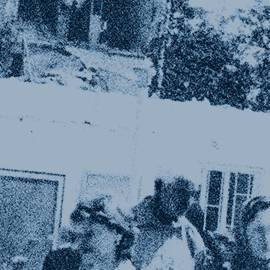The story of a woman who visited her village following a sweeping operation
Place of interview: Ingushetia
Interview date: February 9, 2000
On February 8, 2000, the interviewee arrived at a checkpoint on the administrative border between Ingushetia and the Chechen Republic – near the village of Ordzhonikidzevskaya – with the aim of receiving news as journalists, human rights activists and refugees had gathered there to meet people leaving the battle zone. However, the woman unexpectedly discovered that locals were able to enter Katyr-Yurt. Not informing her relatives of her intention to visit the village, she nevertheless travelled there. The woman states that she witnessed a number of dead bodies lying on the ground on the street where she had lived as well as on other neighboring streets. In one of the houses, eight people from the same family had been killed at once. These were locals and included both adults and children. The dead were found in the basement. In the courtyard of another house, she saw a child between the ages of two and four hung on a gate. Five other people from the same family had also been killed and the child’s mother was injured. According to the interviewee, the family was not from Katyr-Yurt, but were refugees.
The woman’s uncle subsequently travelled to Katyr-Yurt from the Achkhoy-Martan. He removed the hanging child from the gate. The woman’s wounded relatives were kept in the district hospital. A 20-year-old man from the family was killed.
There were also people lying on the road along the streets. The interviewee saw three destroyed cars on the road: a Six, Seven and a Rafik. There were dead bodies inside the cars. A shell had hit the Rafik car, and she could see corpses in its cabin that had been burned but were not completely charred. It appeared that those in the car had attempted to leave the village but were prevented from doing so and were killed right on the road.
The woman also examined other houses, streets and alleys and found more dead bodies. Some also lay on the roadway. In one house, five people had been killed and three others wounded. In another case, directly on the street, she came across the corpse of a 28-year-old acquaintance. She saw the murdered mother and her two-year-old child. In one of the houses she also found a stroller with a dead child inside. The mother of this child was from Gekhi and had been married to a resident from Katyr-Yurt. The mother had been burned.
According to the woman, the situation was even worse in the upper part of Katyr-Yurt, however she was not able to visit this part. According to her, men were taken hostage there, some of whom were killed. The house where they were kept was located on the outskirts of the village. On February 9, 45 wounded victims were removed from the village of Katyr-Yurt. However, the corpses which remained there were yet to be buried. The village, according to the woman, continued to be shelled. In the evening of her departure from Katyr-Yurt, another artillery strike was launched on the village.
Comment from the Natalia Estemirova Documentation Center: the interviewed woman lived as a refugee in Ingushetia. Commencing on February 4 and 5, 2000, the village of Katyr-Yurt – of which she was a native – was bombarded with shelling. Following this, Russian troops carried out a “sweeping operation” in the village. The operation lasted several days and resulted in the deaths of dozens of people, including entire families. The interviewed woman did not speak Russian well, was worried and visibly nervous as she assumed that she was not being believed when she was asked follow-up/clarifying questions.
